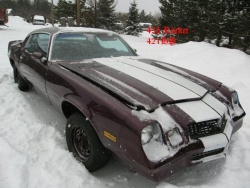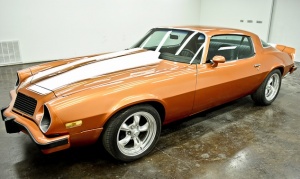GM F platform: Difference between revisions
Ed.higgins (talk | contribs) |
Ed.higgins (talk | contribs) |
||
| (3 intermediate revisions by the same user not shown) | |||
| Line 13: | Line 13: | ||
The second generation F-Body cars were actually released as '1970 1/2' cars, due to extensive delays in the design and production of the new body style. Both cars grew considerably, with fairly drastic changes in styling to match each brand's updated styling across the lineup. Both cars also received engine options in the 7.4 L range in the earlier years of the second generation - 454 in<sup>3</sup> for Chevrolet, and 455 in<sup>3</sup> for Pontiac. However, both of these engines would be discontinued as emissions and fuel-economy restrictions made their production costs prohibitive. Performance continued to decline through 1981, as power levels dropped and weight increased. | The second generation F-Body cars were actually released as '1970 1/2' cars, due to extensive delays in the design and production of the new body style. Both cars grew considerably, with fairly drastic changes in styling to match each brand's updated styling across the lineup. Both cars also received engine options in the 7.4 L range in the earlier years of the second generation - 454 in<sup>3</sup> for Chevrolet, and 455 in<sup>3</sup> for Pontiac. However, both of these engines would be discontinued as emissions and fuel-economy restrictions made their production costs prohibitive. Performance continued to decline through 1981, as power levels dropped and weight increased. | ||
Chevrolet brought back the Z28 | Chevrolet brought back the '''Camaro Z28''' in mid-year 1977, largely in response to American car enthusiast demands as well as the remarkable success of its corporate stablemate, the Pontiac Trans Am. The 1977 '''Camaro Z28''' was equipped with a 350 in<sup>3</sup> and either a Borg Warner 4-speed manual transmission or a TH350 3-speed automatic. | ||
[[Image:Colin's_Monster_Ride.jpg|300px]] | [[Image:Colin's_Monster_Ride.jpg|300px]] | ||
The | The '''Camaro Z28''' came back into the limelight in the box office hit movie, "Transformers" as a central character named “Bumblebee”, Sam Witwicky’s (Shia LaBeouf) first car. One of the most important heroes in the film, Bumblebee was sold on eBay (on July 18 2008) for just over $40,000 USD with proceeds going to charity. | ||
[[Image:Bumblebee.jpg|300px]] | |||
The 1980 and 1981 '''Camaro Z28''' package included an air induction hood scoop, with an intake door that opened under full throttle. | |||
==Third Generation, 1982-1992== | ==Third Generation, 1982-1992== | ||
Latest revision as of 02:14, 17 October 2011
The F platform, or F-body, was General Motors' small rear-wheel drive automobile platform from 1967 until 2002. It was based partially on the GM X platform, which was used for compact applications instead of the sporting intent of the F-Body. The only two vehicles to have been built using the F-Body platform are the Chevrolet Camaro and the Pontiac Firebird. The fourth character in the Vehicle Identification Number for an F-body car is "F".
First Generation, 1967-1969
File:1968ChevroletCamaroZ28.jpg File:Pontiac Firebird.jpg
The first F-body cars were produced in 1967, as GM's response to the Ford Mustang. Camaro was to be named "Panther". Originally designed strictly as the platform for the Camaro, Pontiac engineers were given a short amount of time prior to the Camaro's release to produce a version that matched their corporate styling as well. Production of both cars were at 2 plants,Van Nuys CA and Norwood,OH. The F-Body was available as both a hardtop coupe and a cloth-top convertible. As was GM policy at the time, Chevrolet and Pontiac both installed their own engines; however, the engine lineups were similar. Both cars could be had with either division's base inline six-cylinder engine, a V8 engine of approximately 5.3 liters (327 in3 for Chevrolet, 326 in3 for Pontiac), or a larger V8 engine of approximately 6.6 liters (396 in3 for Chevrolet, 400 in3 for Pontiac). Due to delays with the design of the second-generation car, the 1969 models were produced longer than usual.
Second Generation, 1970-1981
The second generation F-Body cars were actually released as '1970 1/2' cars, due to extensive delays in the design and production of the new body style. Both cars grew considerably, with fairly drastic changes in styling to match each brand's updated styling across the lineup. Both cars also received engine options in the 7.4 L range in the earlier years of the second generation - 454 in3 for Chevrolet, and 455 in3 for Pontiac. However, both of these engines would be discontinued as emissions and fuel-economy restrictions made their production costs prohibitive. Performance continued to decline through 1981, as power levels dropped and weight increased.
Chevrolet brought back the Camaro Z28 in mid-year 1977, largely in response to American car enthusiast demands as well as the remarkable success of its corporate stablemate, the Pontiac Trans Am. The 1977 Camaro Z28 was equipped with a 350 in3 and either a Borg Warner 4-speed manual transmission or a TH350 3-speed automatic.
The Camaro Z28 came back into the limelight in the box office hit movie, "Transformers" as a central character named “Bumblebee”, Sam Witwicky’s (Shia LaBeouf) first car. One of the most important heroes in the film, Bumblebee was sold on eBay (on July 18 2008) for just over $40,000 USD with proceeds going to charity.
The 1980 and 1981 Camaro Z28 package included an air induction hood scoop, with an intake door that opened under full throttle.
Third Generation, 1982-1992
File:Camaro1.jpg File:Transam-wiki.jpg
The third generation of the F-Body was introduced for 1982, as a major redesign with a more modern look and a lighter, better-handling car. In a move that would later happen across almost all GM models, the Firebird switched from Pontiac-designed engines to the same Chevrolet engines that powered the Camaro. This was also the only generation of F-Body to be available with a four-cylinder, the LQ9 Iron Duke. Camaro news included a deal with Jay Signore and IROC to use the nameplate as the official car for the race series in 1985,a contract that ended Dec.31 1989.Camaro owners who wanted the wind in their hair could finally have a convertible(an option missing since 1969) in 1987,although Canadians had to wait a year until 1988 for ragtops.All convertibles started their life as a T-Top car and final installation was sub-contracted to ASC.The last Firebird to be built with an engine not available in the Camaro was the 1989 Turbo Trans Am, which had a turbocharged 3.8 L Buick V6, derived from the Buick Regal. Other Available engines were: L98, the TPI 350ci; LB9, the TPI 305ci; L03, the TBI 305ci; L69, the Carb (HO) 305ci; LG4, the carb (non HO) 305ci; LU5, the CFI (Crossfire) 305ci; LH0, the MPFI 191ci v6; LB8, the MPFI 173ci v6; LC1 carb 173ci v6; LQ8, the carb 151ci L4. Power was put to the ground through the TH-700R4 4 speed automatic or a T-5 5 speed Manual, with a variety of rear end ranging from 2.73 up to 3.73
Fourth Generation, 1993-2002
File:2002ChevroletCamaroSS35-001.png File:3-29-04-1.jpg
The fourth generation of F-body was released in 1993.The entire life-cycle of the 4th gen was produced at the GM plant in Ste. Therese,QC Canada, a first in the history of F-Bodies. It was an extensive revision to the third generation car, instead of a clean-sheet design. It was produced until the platform was canceled at the end of the 2002 model year. Unlike most of the years past, the engine choices were simplified considerably; each year, on both the Camaro and the Firebird, there was only one V6 and one V8 available. For 1993 to 1995, the V6 was the 3.4 L (208 in³) 60°; 1996-2002 cars received the 3.8L (231 in³) 3800 Series II V6. 1993-1997 V8 cars shipped with the 5.7L (350 in³) LT1, while 1998-2002 cars received the 5.7L (346 in³) LS1. Both engines were available with the 4L60E four-speed auotmatic transmission. V6 engines with a manual transmission had a Tremec T5 five-speed unit; the manual for V8 cars was the T-56 six-speed, manufactured by either Borg-Warner or Tremec. An optional [[Hurst Performance|Hurst]]-supplied shifter was also available on V8 models. There was no convertible for 93 but 1996 saw the return of the "SS" badge for Camaro and enjoyed a magazine-print frenzy with its' many cover sightings.
The F-Body has not had a direct replacement since production ceased in 2002; the closest would be the modern Pontiac GTO, though it is a larger and heavier car. GM has announced that the Camaro will return in 2009 as a 2010 model, most likely utilizing the Zeta chassis. There are no plans to revive the Firebird nameplate, to the dismay of its fans.
Camaro Production Numbers 1967-1990



